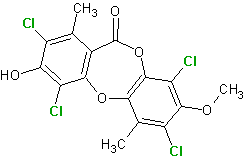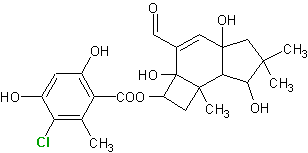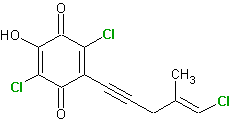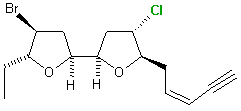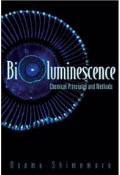|
Weitere Quellen: |
|
Verwandte Themen: |
|
|
Chlorhaltige Naturstoffe |
|
Entgegen früherer Annahmen nutzt die Natur das Element Chlor in einer ganzen Reihe von natürlichen Chlorverbindungen. von denen hier einige beispielhaft mit Strukturformeln abgebildet sind. |
|
Aurantosid B |

|
Aurantosid B: C35H44Cl2N2O15; CAS: 137895-71-7. PubChem [Daten: 6450990; 10556854] Aurantoside: In verschiedenen Schwämmen (Theonella sp.) vorkommende Polyenoyl-Tetramsäuren mit cyctotoxischer und antifungischer Wirkung; man unterscheidet die Aurantoside A, B, C (Homophymia conferta), D (Siliquariaspongia japonica), E (Siliquariaspongia japonica), F (S. japonica), G (Theonella swinhoei), H (Theonella swinhoei), I (Theonella swinhoei), J (Theonella swinhoei), K (Melophlus sp.) und L (Siliquariaspongia japonica). |
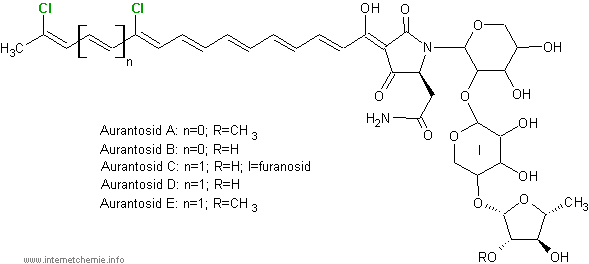
|
Referenzen:
|
Diploicin |
|
Strukturformel:
|
Diploicin Wurde als erster halogenierter Naturstoff identifiziert (1904; Strukturaufklärung 1934) Vorkommen: Buellia canescens (Flechte); |
Mellodonal |
|
Strukturformel:
|
Mellodonal Vorkommen: Armillaria mellea (Gemeiner Hallimasch)
|
Mycenon |
|
Strukturformel:
|
Mycenon C11H5Cl3O3 - CAS 131651-40-6 Vorkommen: Actinomycetes: Mycena sp.; Referenzen: Mycenon, a new metabolite from a Mycena species TA 87202 (basidiomycetes) as an inhibitor of isocitrate lyase [The Journal of Antibiotics; Vol.43 (1990), No.10 pp.1240-1244] |
Notoryne |
|
Strukturformel:
|
Notoryne Vorkommen: Laurencia nipponica; |
Telfairin |
|
Strukturformel:
|
Telfairin; engl. telfairine. C10H14Cl3Br Vorkommen: Plocamium telfairiae (Seetang); mit Lindan vergleichbare Toxizität; Wirkung gegen Mückenlarven. |
|
Informationen über natürliche Organochlorverbindungen in der Umwelt: |
|
- |
Natürliche Organohalogenverbindungen in der Umwelt [PDF Text, Universität Hannover] |
|
- |
Umweltgifte vom Gabentisch der Natur [PDF Text; Spektrum der Wissenschaft] |
|
Produkte und Firmen: |
|
- |
Datenbank: Kommerziell erhältliche Biochemikalien |
|
Sonstige Hinweise: |
|
|
|
|
Literatur- und Buchempfehlungen zum Thema Biolumineszenz: |
|
Osamu Shimomura Bioluminescence: Chemical Principles and Methods This book, written by a distinguished scientist in the field, provides a comprehensive overview of the biochemical aspects of all luminous organisms currently known. It is the first and only book that provides chemical information on all known bioluminescence systems, in a single volume. Some 35 different types of bioluminescence organisms are discussed in 10 chapters. The descriptions include: a history of the discovery of luminescence substances such as luciferins, luciferases and photoproteins; the process of research, explaining how luminescent substances have been isolated and purified; the properties of luminescent substances; and the reaction modes and mechanisms involved, as interpreted currently. Important experimental data and graphs are included in the book, making time-consuming reference searches almost unnecessary. Helpful advice for experimentalists is given in an appendix. World Scientific Publishing Company; 2006. |
